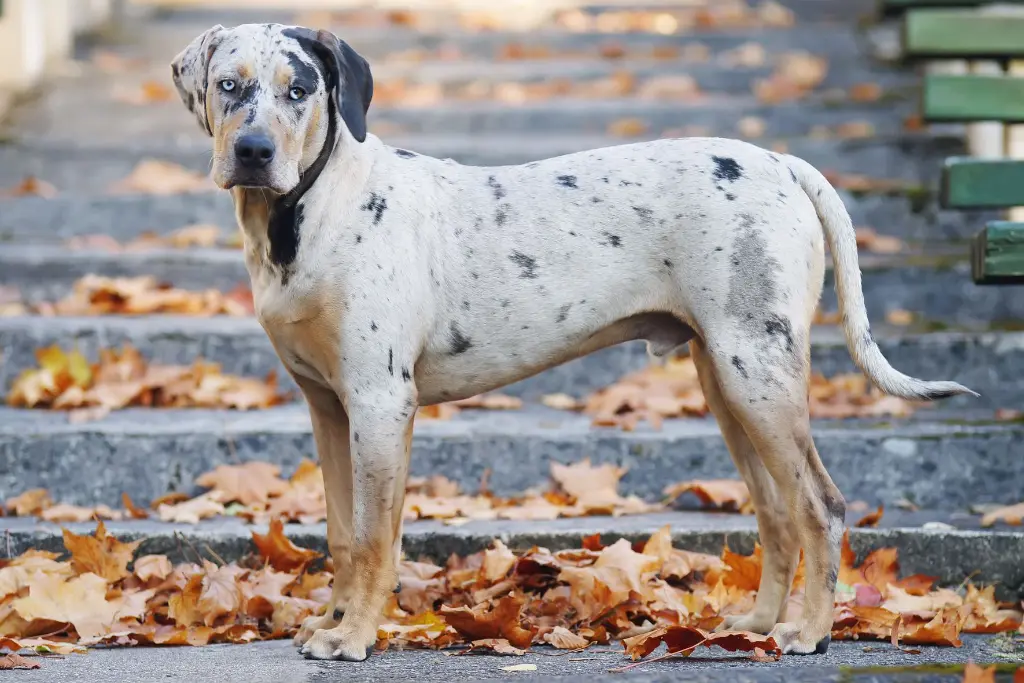The Catahoula Leopard Dog, also known as the Catahoula Cur, is a multifunctional dog breed originating from the United States. Developed by early American settlers, this breed excels in protecting properties, herding livestock, and hunting various animals. Its name derives from the predominant color pattern, resembling the mottled coat of a leopard.
History
The Catahoula Leopard Dog has been evolving in the southeastern United States since the 18th century. Its origin likely involves a mix of dogs brought to America by the Spanish, along with contributions from native Mexican breeds. Some theories suggest French, English, Irish, and Scottish immigrant dogs also played a role.
By the mid-20th century, changes in lifestyle led to a decline in these multifunctional dogs, nearly causing the breed’s extinction. However, dedicated efforts by individuals like Richard McDuffie, Leroy E. Smith, and A.W. Carter revived the breed. The American Leopard Hound was recognized by the United Kennel Club (UKC) in 1998 as the “Leopard Cur” and later renamed the “Leopard Hound” in 20081.
Appearance
- Powerful Build: The Catahoula Leopard Dog is muscular, elongated, and slightly longer than tall.
- Agility: Long legs allow for swift movement, especially in rugged terrain.
- Head: Broad head with a moderate stop and a sturdy, medium-length muzzle.
- Ears: High-set, drooping ears.
- Tail: Straight, low-set, and can vary in length.
- Coat: Dense, double coat—rough outer layer and a woolly undercoat. Ideal for working in thick brush and forests.
- Color: The Catahoula comes in various colors, including merle (mottled), yellow, black (with brindle or fire markings), red, and blue/gray.
Functionality
- Hunting: Primarily used for firearm-assisted hunting.
- Farm Work: Originally bred for herding and guarding livestock.
- Versatility: Adaptable to various tasks due to its intelligence and work ethic.
Understanding the Australian Cattle Dog Temperament
The temperament of the Australian Cattle Dog is best described as alert, watchful, and highly energetic. Bred for herding cattle in the harsh Australian outback, these dogs exhibit traits such as intelligence, independence, and a strong work ethic. However, they can also be wary of strangers and exhibit a protective instinct towards their family and territory.
Characteristics of Australian Cattle Dog Temperament:
- Intelligence: Australian Cattle Dogs are exceptionally intelligent and thrive on mental stimulation. They excel in activities such as obedience training, agility, and even advanced tricks.
- Energetic: With boundless energy, these dogs require plenty of exercise and mental stimulation to prevent boredom and destructive behaviors.
- Loyalty: Australian Cattle Dogs are fiercely loyal to their owners and form strong bonds with their families.
- Independent: Due to their working heritage, Australian Cattle Dogs can display independent streaks, making early socialization and training crucial.
- Protective: While not aggressive, these dogs are naturally protective of their territory and may exhibit wary behavior towards strangers.
Australian Cattle Dog Mix Breeds
The Australian Cattle Dog is often crossed with other breeds to create unique mixes that combine the best traits of both parents. Some popular Australian Cattle Dog mixes include:
- Australian Shepherd Cattle Dog Mix: Combining the intelligence of the Australian Cattle Dog with the herding instincts of the Australian Shepherd, this mix is highly versatile and trainable.
- German Shepherd Cattle Dog Mix: Known for their loyalty and protective nature, German Shepherd Cattle Dog mixes make excellent family guardians.
- Border Collie Cattle Dog Mix: This mix results in a highly energetic and intelligent dog that excels in various canine sports and activities.
Adopting an Australian Cattle Dog
Adopting an Australian Cattle Dog can be a rewarding experience for the right family. However, it’s essential to consider the following factors before bringing one into your home:
- Activity Level: Australian Cattle Dogs require ample exercise and mental stimulation to thrive. Ensure that you can provide daily walks, playtime, and training sessions.
- Training Needs: These dogs are highly intelligent but can be stubborn at times. Consistent and positive reinforcement training methods are key to success.
- Space Requirements: Australian Cattle Dogs are not well-suited to apartment living and thrive in homes with access to a securely fenced yard where they can run and play.
- Socialization: Early and ongoing socialization is crucial to prevent shyness or aggression towards strangers and other animals.
Australian Cattle Dog vs. Blue Heeler: Is There a Difference?
The terms «Australian Cattle Dog» and «Blue Heeler» are often used interchangeably, leading to confusion among potential owners. However, there is no significant difference between the two; they refer to the same breed. The nickname «Blue Heeler» comes from the breed’s tendency to nip at the heels of cattle during herding, and it also refers to the blue or blue-speckled coat that is characteristic of the breed.
Australian Cattle Dog Price and Adoption
The cost of purchasing an Australian Cattle Dog from a reputable breeder can vary depending on factors such as lineage, pedigree, and location. On average, you can expect to pay anywhere from $500 to $1,500 for a puppy. However, adoption is also a viable option for those looking to provide a loving home to a dog in need. Rescue organizations and shelters often have Australian Cattle Dogs available for adoption at a fraction of the cost of purchasing from a breeder.
Australian Cattle Dog Lifespan and Health
On average, Australian Cattle Dogs have a lifespan of 12 to 15 years when properly cared for. Like all breeds, they are susceptible to certain health issues, including:
- Hip Dysplasia: A common orthopedic condition that can cause pain and mobility issues.
- Progressive Retinal Atrophy: A degenerative eye disease that can lead to vision loss.
- Deafness: Some Australian Cattle Dogs, particularly those with predominantly white coats, may be prone to deafness.
- Elbow Dysplasia: Similar to hip dysplasia, this condition affects the elbows and can cause lameness and discomfort.
Regular veterinary check-ups, a balanced diet, and proper exercise are essential for maintaining the health and well-being of your Australian Cattle Dog.
Australian Cattle Dog Colors and Coat Variations
Australian Cattle Dogs are known for their striking coat colors and patterns. The breed standard recognizes two primary coat colors: blue and red. Blue Cattle Dogs can range from a light blue-gray to a deep slate color, often with black or tan markings. Red Cattle Dogs typically have a rich, solid red coat with or without markings.
Red Australian Cattle Dog: A Unique Variation
While most Australian Cattle Dogs are either blue or red, there is a variation known as the «Red Heeler.» These dogs have a predominantly red coat with distinct markings, including speckles or patches of white on the chest, legs, and face. Red Heelers exhibit the same intelligence, energy, and loyalty as their blue counterparts, making them equally suitable for work or companionship.
Conclusion
The Catahoula Leopard Dog’s rich history, striking appearance, and multifunctional abilities make it a remarkable breed. Whether on the farm, in the wild, or as a loyal companion, this dog continues to leave its paw print on American heritage.

